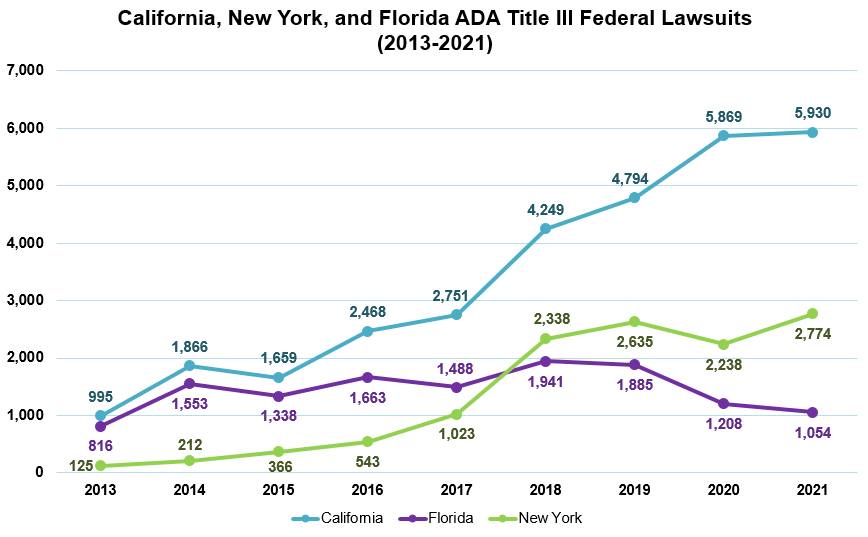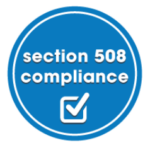Web accessibility in the State of California is becoming more accessible due to stringent state and federal laws. The reason is because lawsuits and settlements are increasing steadily across the state. The state is also introducing new and more stringent accessibility laws.
California, a frontrunner in progressive policies and social consciousness, takes web accessibility very seriously. With a diverse population and a commitment to upholding the rights of all its residents, California has embarked on a mission to make the digital realm accessible to everyone, irrespective of their physical or cognitive limitations.
In this introduction, we will explore the essence of web accessibility in the State of California, understanding the laws, initiatives, and efforts put forth by both the government and private entities to bridge the accessibility gap.
California takes web accessibility seriously
Web accessibility in the State of California is crucial for several compelling reasons, including the following:
Inclusive Society
Web accessibility ensures that all people, regardless of their physical or cognitive abilities, can access and interact with the web. By making the web more accessible, we create a more inclusive society where everyone has equal opportunities to participate, learn, shop, work, and communicate.
Legal Requirements
The California Unruh Civil Rights Act and the Americans with Disabilities Act (ADA) require businesses to provide equal access to goods, services, and facilities. Websites are now considered a part of these facilities, and failure to make them accessible can lead to legal ramifications, including lawsuits and fines.
Large Disabled Population
According to the Centers for Disease Control and Prevention (CDC), 26% of adults in the United States have some type of disability. Given California’s substantial population, a significant number of its residents fall into this category. Ensuring web accessibility means catering to this considerable section of the populace and not excluding them from crucial online services and resources.
Aging Population
With an increasing aging population in California, many people experience a natural deterioration in vision, hearing, motor skills, and cognition. Web accessibility caters to these needs, ensuring that senior citizens can remain connected and engaged with the digital world.
Enhanced Usability for Everyone
Web accessibility is not just about those with disabilities. Implementing web accessibility principles often improves the overall user experience for everyone, making websites easier to navigate, understand, and use.
Economic Considerations
From a business perspective, accessibility increases the potential customer base by including people with disabilities. This broader audience can drive increased traffic, engagement, and ultimately, revenue.
Web accessibility in California is a commitment to equity and inclusion. It ensures all Californians, regardless of their physical or cognitive abilities, can fully participate in the digital age.
The Department of Justice (DOJ) and Web Accessibility
The Department of Justice (DOJ) has taken online accessibility seriously over the past several years. The ADA has strict requirements about what needs to be available to customers in a physical storefront. But the law in its original form did not have specific requirements for online websites. The Department of Justice (DOJ) provided notice of creating a standard for websites and other guidance in 2010.
This includes how to work with third-party content, time businesses have to comply, and the expectations for websites. The notice period lasted till 2016, with the Obama administration’s DOJ aggressively looking at lawsuits and working to reach settlements.
In 2016, however, the Trump administration declined to weigh in on motions, including Robles vs. Domino’s Pizza. Both the Senate and the House of Representatives wrote to the DOJ.
However, they receive letters in return stating that Congress must tackle these regulations. The Congress confirms that the ADA covers websites, and left it at that.
During this time, ADA lawsuits skyrocketed quickly. There was an explosion in cases from 2017 to 2018. This resulted in a 181% increase in the number of federal court filings. The number of lawsuits has only increased ever since. The filings in New York took the lead, followed by Florida and California. California had a huge number of state lawsuits, but were third in federal lawsuit filings.
California Title III Federal Lawsuit Filings Hit an All Time High
The number of ADA Title III lawsuits filed in federal court in 2020 dipped slightly under 11,000. However, te numbers have come roaring back in 2021. There were at least 11,452 federal filings last year which is an all-time record from 2013 when there were only 2,722 suits. That is an astonishing 320% increase in eight years!
Total Number of ADA Title III Federal Lawsuits Filed Each Year: January 1, 2013 – December 31, 2021

Source: Seyfarth Shaw
What do the numbers tell us?
California remains hotbed for a web accessibility lawsuit filings. This is because plaintiffs can add a state law discrimination claim under the Unruh Act. They can get $4,000 in statutory damages for every incident of discrimination without even having to prove an actual injury.
The filings in California accounted for just over half the total number of filings nationwide. New York was a distant second, with 2,774 lawsuits, and Florida was third, with only 1,054 lawsuits. In short, there are more ADA Title III suits in California than in all other 49 states combined.
California, New York, and Florida ADA Title III Federal Lawsuits (2013-2021)

Source: Seyfarth Shaw
Top Ten States with Federal ADA Title III Lawsuits Filed: January 1, 2021 – December 31, 2021

Source: Seyfarth Shaw
ADA Related web accessibility lawsuits in California
Robles v. Domino’s Pizza (2019)
In the landmark case Robles v. Domino’s Pizza, Guillermo Robles, a visually impaired man, sued the pizza chain alleging that its website and mobile application were not accessible to him, violating the Americans with Disabilities Act (ADA). Robles claimed he couldn’t order food from the Domino’s website and mobile app using his screen-reading software. Initially, a district court ruled in favor of Domino’s, citing lack of clear guidelines from the Department of Justice on web accessibility.
However, in 2019, the Ninth Circuit Court of Appeals overturned this decision, asserting that the ADA does apply to websites and apps if they connect to physical businesses. The U.S. Supreme Court declined to hear Domino’s appeal, leaving the Ninth Circuit’s decision in place and affirming the critical principle that digital spaces must be accessible to all users.
What makes California Different?
Web accessibility in the State of California is becoming one of the most active legal spaces over the past decade. And that’s due to a number of different factors. Let’s look at each one of them.
State Digital Accessibility Laws
California’s Unruh Act
The Unruh Civil Rights Act is a piece of legislation in the U.S. state of California that prohibits discrimination by businesses. The Act seeks to protect individuals from discrimination in California. It ensures businesses treat all people fairly and without prejudice.
Enforcement of the Unruh Act is by civil litigation. Individuals who face discrimination can file a lawsuit. If successful, they can recover actual damages, statutory damages (a minimum of $4,000), attorney’s fees, and costs. In some cases, a court may also award punitive damages.
Moreover, a court can order businesses found guilty of violating the Unruh Act to cease their discriminatory practices. In addition, a successful plaintiff may be able to obtain an injunction, a court order that requires the defendant to stop engaging in illegal conduct.
California Government Code Section 11546.7 – State Agency Website Compliance
Beginning July 1, 2019, state agencies and their entities must ensure that their websites comply with Government Code Section 11546.7. The requirements in the Section are as follows:
- Before July 1, 2019, and before July 1 biennially thereafter, the director and chief information officer of each state agency or state entity shall post on their Internet website a signed certification that confirms that their website is in compliance with Sections 7405 and 11135, and the Web Content Accessibility Guidelines (WCAG) 2.0, Level AA success criteria (minimum).
- The Director of Technology shall create a standard form that each state agency’s or state entity’s chief information officer shall use to determine whether the state agency’s or state entity’s Internet Web site is in compliance with the accessibility standards specified in subdivision (a).
How codemantra helps state agencies achieve compliance?
codemantra helps state, local and federal governments comply with WCAG 2.0, ADA, Section 508 mandates. These require your websites and digital documents like PDF’s to be equally accessible to all users, especially people with visual impairments.
Our AI-powered platform accessibilityInsight offers scalable modules for robust compliance reporting and validation across all document types as per WCAG 2.1 standards. The platform helps to auto-remediate documents as per ADA, WCAG 2.1 Level AA, and Section 508 standards to achieve compliance at scale. It also allows users to perform interactive remediation as needed. We have worked with several California state agencies to help them with their remediation strategies with a very cost-effective solution.
Interested to know more?
Call us at 1 (800) 769-9715. Email: engage@codemantra.com for more information on how state agencies can achieve compliance as per state and federal accessibility laws.









